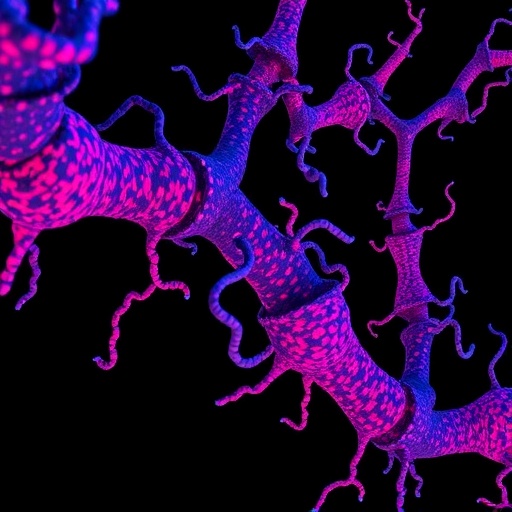
In the relentless pursuit to decode the molecular underpinnings of Parkinson’s disease, a recent groundbreaking study has unveiled pivotal insights about the pathological involvement of alpha-synuclein, a protein long implicated in this neurodegenerative disorder. Researchers led by Mahul-Mellier and colleagues have delved deeply into the nuances of alpha-synuclein truncations, particularly those occurring at the protein’s C-terminal end, elucidating their distinct and differential roles in the formation of pathological aggregates known as Lewy bodies. These findings promise to refine our understanding of Parkinson’s disease pathology and open new avenues for therapeutic interventions targeting alpha-synuclein’s aberrant behavior.
Alpha-synuclein has been a molecular enigma due to its intrinsic disorder and multifaceted pathology. It is predominantly a neuronal protein that, upon misfolding and aggregation, contributes to the hallmark Lewy body inclusions observed in Parkinson’s disease and related synucleinopathies. While the full-length protein has been extensively studied, truncations—specifically at the C-terminus—have emerged as critical modifiers of its aggregation propensity, fibril formation, and cytotoxicity. This study systematically dissects these C-terminal truncations to reveal their distinct impacts on the biogenesis and maturation of alpha-synuclein aggregates.
Employing a combination of cutting-edge biochemical assays, advanced imaging techniques, and innovative cellular models, the research team demonstrated that specific C-terminal truncations do not merely accelerate alpha-synuclein aggregation but uniquely influence the ultrastructure and biochemical composition of resulting Lewy bodies. The findings challenge previously held notions that truncation is a uniform process merely enhancing aggregation, instead suggesting a more nuanced modulation of protein pathology. This differential effect provides a compelling mechanistic explanation for the heterogeneity observed in Lewy body pathology among Parkinson’s disease patients.
The researchers utilized site-directed mutagenesis to create alpha-synuclein variants truncated at distinct C-terminal residues. Through rigorous comparative analyses, they observed that truncations at proximal versus distal sites dramatically altered the aggregation kinetics and the resultant fibrillar architecture. Truncations closer to the middle of the C-terminus induced more rapid aggregation and formation of compact, densely packed fibrils reminiscent of canonical Lewy bodies, while distal truncations resulted in aberrant fibrillary forms with less compactness and altered biochemical properties. This suggests that subtle alterations at discrete C-terminal positions fine-tune the pathological outcome.
More profoundly, the study reveals that C-terminal truncations affect not only the physical characteristics of aggregates but also their biological activity. In vitro experiments using neuronal cultures demonstrated differing cytotoxic profiles associated with each truncation variant. Proximal truncations corresponded to aggregates that elicited pronounced mitochondrial dysfunction and heightened cellular stress responses, hallmarks of Parkinsonian neuron demise. Conversely, distal truncations generated less acutely toxic assemblies, highlighting a gradient of pathogenic potential linked directly to truncation site.
Further elucidating the molecular impact, the investigators explored the interaction between truncated alpha-synuclein species and key cellular proteins. Their data indicated that certain truncations increased the recruitment of intracellular chaperones and ubiquitin-proteasome components into the aggregates, potentially reflecting differential cellular handling and degradation pathways. This interplay hints at a complex balance between protein aggregation and cellular defense mechanisms that could decisively influence disease progression and severity.
Intriguingly, the study also examined Lewy body formation in human brain samples and observed a striking correlation between the pattern of C-terminal truncations and disease stage. Early-stage Parkinson’s brains predominantly exhibited distal truncations, mirroring the less compact fibrils seen in vitro, whereas advanced stages showed predominantly proximal truncations associated with mature, densely packed Lewy bodies. This temporal evolution proposes that alpha-synuclein truncation is a dynamic post-translational modification shaping the trajectory of aggregate maturation in vivo.
The implications of this research extend beyond molecular pathology, offering promising perspectives for therapeutic targeting. Interventions designed to modulate specific truncation events or to inhibit the generation of the most deleterious truncated forms of alpha-synuclein could prove instrumental in halting or reversing the progression of synucleinopathies. Furthermore, diagnostic tools capable of detecting truncation patterns might facilitate early disease detection and more accurate staging, personalizing patient management strategies.
Equally noteworthy is the technology-driven framework that enabled these discoveries. By integrating super-resolution microscopy, cryo-electron tomography, and quantitative proteomics, the researchers painted a comprehensive molecular landscape of alpha-synuclein aggregation with unparalleled clarity. These methodologies not only underscored the heterogeneity within Lewy body pathology but also provided quantitative insights into protein conformations previously invisible to standard analyses.
As Parkinson’s disease continues to affect millions globally, the quest for disease-modifying therapies remains urgent. This study’s elucidation of the differential roles of C-terminal truncations in alpha-synuclein aggregation offers a tangible molecular target. Future investigations could extend to in vivo models and clinical samples from larger patient cohorts, validating truncation-modulating therapies and assessing their efficacy in slowing neurodegeneration.
Moreover, the nuanced understanding of alpha-synuclein truncation effects prompts reconsideration of existing experimental approaches and pharmaceutical designs. Rather than broadly targeting alpha-synuclein aggregation, a more refined strategy might focus on specific truncation forms that are critically pathogenic. This shift in paradigm could herald a new era in Parkinson’s research where therapeutic precision is grounded in molecular specificity.
The discovery also raises essential questions about the enzymatic machinery responsible for these truncations and their regulation within the neuronal milieu. Identifying proteases or cleavage factors that generate particular truncations could offer indirect but effective targets to modulate alpha-synuclein pathology. Furthermore, understanding how cellular stressors, genetic susceptibilities, or environmental factors influence truncation patterns may illuminate disease heterogeneity observed clinically.
While the study primarily focuses on Parkinson’s disease, the findings might resonate across other synucleinopathies such as dementia with Lewy bodies and multiple system atrophy. Since Lewy body pathology is a shared feature, the differential roles of alpha-synuclein truncations could contextualize the variability in clinical manifestations and pathology among these disorders. Cross-disease comparisons could therefore be highly insightful and catalyze the development of broad-spectrum anti-synuclein therapies.
In summation, Mahul-Mellier et al.’s research constitutes a seminal advance in the molecular neuropathology of Parkinson’s disease by disentangling the complex relationship between alpha-synuclein C-terminal truncations and their pathological outcomes. By revealing that distinct truncation sites exert markedly different effects on protein aggregation, toxicity, and Lewy body maturation, this study reframes our understanding of synuclein aggregation as a finely tuned and heterogeneous process. The implications for diagnostics, therapeutics, and fundamental neuroscience research are profound, setting a new course toward deciphering and combating synuclein-driven neurodegeneration.
Subject of Research: The role of alpha-synuclein C-terminal truncations in Parkinson’s disease pathology and Lewy body formation.
Article Title: Differential role of C-terminal truncations on alpha-synuclein pathology and Lewy body formation.
Article References:
Mahul-Mellier, AL., Altay, M.F., Maharjan, N. et al. Differential role of C-terminal truncations on alpha-synuclein pathology and Lewy body formation. npj Parkinsons Dis. 11, 261 (2025). https://doi.org/10.1038/s41531-025-01084-y
Image Credits: AI Generated
Tags: advanced imaging techniques in researchalpha-synuclein pathologybiochemical assays in neuroscienceC-terminal truncations in alpha-synucleincellular models in neurobiologydistinct roles of protein truncationsLewy body formationneurodegenerative disorders researchParkinson’s disease molecular mechanismsprotein aggregation in synucleinopathiestherapeutic targets for alpha-synucleinunderstanding alpha-synuclein misfolding





